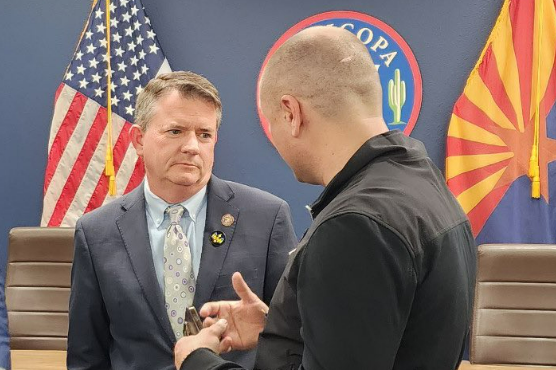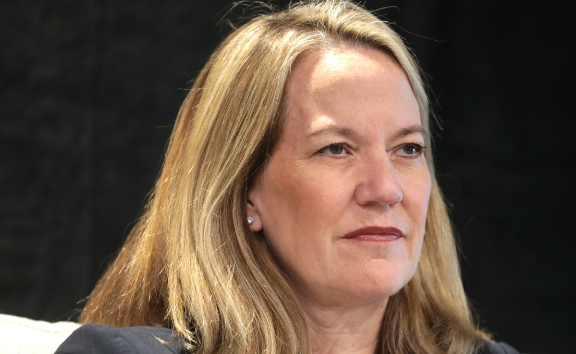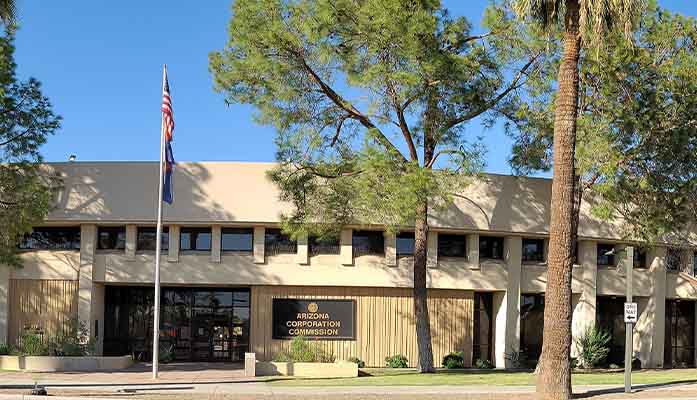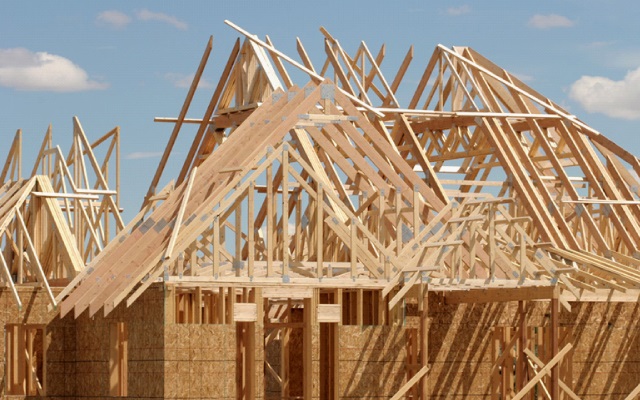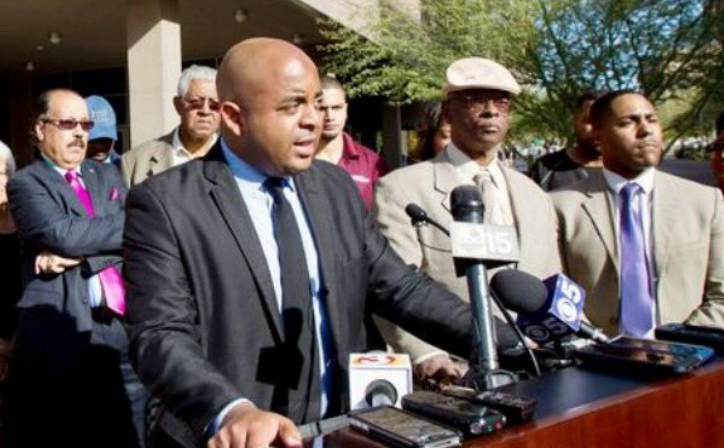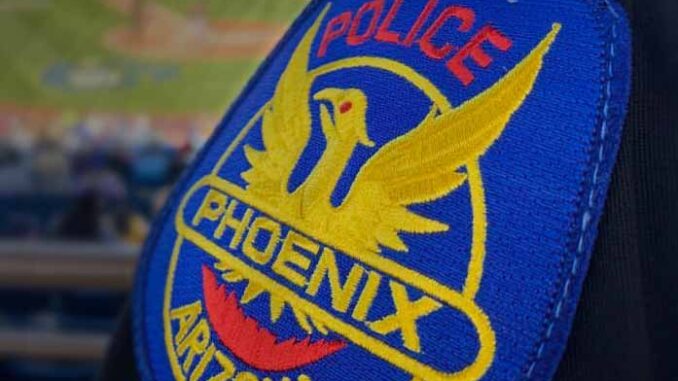
by Daniel Stefanski | Jun 6, 2023 | News
By Daniel Stefanski |
A long-time Arizona Republican elected official is stepping away from public service.
Last week, Maricopa County Supervisor Bill Gates announced that he will not run for re-election in 2024 and intends to pursue other interests and opportunities.
Gates devoted a good deal of the statement to reminisce on his time of service to the state, writing, “For over thirteen years it has been my honor to serve my home state of Arizona on the Phoenix City Council and the Maricopa County Board of Supervisors. As this chapter comes to an end, I rest well knowing that I led with integrity, compassion, and dignity. Regardless of personal partisan preferences or external pressure, I remained focused on making our region the best place to live, work, and raise a family. I am proud to be a principled and limited government Republican. At the city of Phoenix, I cut through the bureaucracy and helped shape a more efficient and responsive government operation. At Maricopa County, I kept government lean, taxes low, supported our most vulnerable residents, and told the truth about our elections in the face of false information.”
The Supervisor thanked many people in his statement, including his colleagues, administrative team, Chief of Staff, supporters, residents of his district, and Maricopa County employees. He saved his most endearing comments, though, to show his gratitude to his family, adding, “To my wife and three daughters, thank you for being my rock, my foundation, and my inspiration. The past few years haven’t always been easy; however, I am a better man, colleague, and public servant because of you.”
Many Arizona officials reacted to the surprising news from Gates. Democrat Representative Marcelino Quiñonez tweeted, “Thank you Supervisor Gates for your years of service. You demonstrated courage & leadership under extraordinary & unjust circumstances. And while our politics might differ, your example must be celebrated by all. Best of luck in your future endeavors.”
Republican Representative Austin Smith used his platform to look ahead at the election to replace Gates on the Board, posting, “I am ready to work and support the most trusted conservative candidate who can win replacing Bill Gates on the Maricopa County Board of Supervisors.”
The 2024 election will be a pivotal time for the future of the Board and Maricopa County elections. In addition to Gates’ now-open seat, the other Republicans and lone Democrat on the panel – plus Recorder Stephen Richer – face primary and general elections.
Daniel Stefanski is a reporter for AZ Free News. You can send him news tips using this link.

by Daniel Stefanski | Jun 5, 2023 | News
By Daniel Stefanski |
Days after Republican legislators warned of possible ethical repercussions over Democrat Attorney General Kris Mayes’ public statements against the state’s Empowerment Scholarship Account program, a private citizen filed a formal complaint against Arizona’s top prosecutor.
On May 31, according to a document received and reviewed by AZ Free News, Charlie Schinke of Chandler filed a charge against Attorney General Mayes with the State Bar of Arizona.
Schinke requests “that the Bar Counsel initiate an investigation to determine whether attorney (and Attorney General) Kristin K. Mayes has breached the foundational duties of loyalty and confidentiality she owes to her clients, in violation of Arizona Rules of Professional Conduct 1.6 and 1.7.” The Chandler resident writes, “In just the last month, Ms. Mayes appeared on television to threaten one of her clients with an investigation that could carry potential criminal dimensions, and publicly admonished another client in letters that she distributed in a press release.” He asserts that “the Attorney General serves state agencies as a counselor and confidante; she does not (and cannot) control, regulate or punish them.”
The two allegations that Schinke uses to base his complaint, are Mayes’ April 17 letter to Director Thomas Buschatzke of the Arizona Department of Water Resources, where she “launched into an extended critique of the agency’s studies of so-called active management areas and demanded that Director Buschatzke supply her with documentation evidencing the agency’s compliance with its responsibilities;” and her May 21 interview, in which Mayes “announced that her office ‘is going to be looking at fraud, waste and abuse in the universal school voucher program.’”
Schinke cites Arizona case law that reflects the lawful containment of the Attorney General’s duties, highlighting a portion of Brnovich v. Arizona Board of Regents, which says, “In Arizona, unlike some other states, the Attorney General has no inherent or common law authority… [T]he authority of the Attorney General must be found in statute.” He writes that “the legislature has designated the Attorney General the ‘chief legal officer of the state,’ and in that capacity she is ‘the legal advisor of the departments of this state and [must] render such legal services as the departments require.’”
The author of the complaint ends his letter to the State Bar with two charges, stating, “Attorney General Mayes’ public criticisms of, and threats to investigate her clients are inconsistent with her duties of confidentiality and loyalty.”
Schinke reminded the Bar about a previous case it considered. In that case, former Attorney General Mark Brnovich faced charges due to allegations that “his public criticisms of, and adverse legal actions against, the agency violated his ethical responsibilities.” Schinke ends his letter, pleading with the Bar to exercise the “same scrutiny” with Attorney General Mayes “that her predecessor received,” adding a line about the “Bar’s self-professed commitment to non-partisanship.”
Schinke’s letter comes just six days after a bicameral group of Republican lawmakers, led by Senate President Warren Petersen and House Speaker Ben Toma, transmitted a letter to Mayes, demanding that she “publicly retract (her) patently false statements attacking ESAs and impugning the motives of thousands of parents that use ESAs to provide the best education for their children.” In their letter, the legislators write: “Of course, Arizona’s Ethical Rules do not tolerate the initiation of criminal proceedings absent probable cause to believe that any parent has committed a crime. See Arizona Ethical Rule 3.8 (listing the special ethical responsibilities of a prosecutor). Further, it would raise ethical questions if a government attorney were to publicly insinuate that a current client is engaging in misconduct with no factual basis. See, e.g., Arizona Ethical Rule 1.7 (imposing a duty of loyalty to a current client).”
Mayes does not appear to have publicly commented on the complaint.
Daniel Stefanski is a reporter for AZ Free News. You can send him news tips using this link.

by Daniel Stefanski | Jun 5, 2023 | News
By Daniel Stefanksi |
Arizona Corporation Commissioner Kevin Thompson announced the successful inclusion of top-line priorities in the recently signed budget for the state – negotiated between Republican legislators and Democrat Governor Katie Hobbs. While Hobbs apparently failed to incorporate some main requests for same-party officials in the Attorney General’s and Secretary of State’s offices, many Republicans around the state, including Thompson, were more than pleased with their budget advances.
In an Instagram post, Thompson revealed the following budget gains for the Corporation Commission:
- “$6M in new dedicated funds to increase staffing levels and increase employee salaries by 10%.
- Another $7M in one-time funding to replace the Commission’s outdated business filing computer system, which will help improve the overall customer experience for Arizona’s 1.3M active LLC’s and another 578,000 active corporations registered in our state.”
Thompson also ensured that these wins were fiscally responsible, adding that the funding was secured “using existing Commission funding streams, incurring no additional expense for the taxpayer.”
The freshman commissioner noted the difficulty of this accomplishment, sharing that “many scoffed at the idea of our ambitious supplemental budget request” due to the fact that “the Commission hadn’t received new dollars from the legislature in years.”
This action was a priority of Thompson’s – and his fellow freshman Commissioner, Nick Myers – since they were sworn into office in January. In his inauguration speech, Thompson promised to pursue increased funding for Corporation Commission staff, saying, “With that, I want to immediately work to bring our staffing levels back to where they should be, and secure the livable wages our hardworking public servants deserve. We can’t continue to do more to service the public with less and expect our employees to have quality of life in this economy. I will work with our Executive Director and legislature to seek an increase in our annual budget and improve salaries for our employees. We have to keep pace with other state agency employee pay.”
Not only did this funding not add any more dollars to the state’s general fund, it will certainly help Arizona ratepayers and those who interact with the Corporation Commission – as Thompson highlighted in his recent social media post: “One of the significant consequence of being understaffed and under-resourced is that Arizona has consistently ranked in the bottom tier nationally in processing utility rate cases—it takes fifty percent longer to process a rate case in Arizona – resulting in delays to build new generation and replace critical infrastructure, driving up ratepayer costs and further destabilizing our regulatory and investment climate.”
Thompson also praised Myers, who ran as a team with him in 2022, for his co-labors in securing new funding for the Commission. Thompson’s and Myers’ November victories kept Sandra Kennedy and Lauren Kuby from those seats, which would have given the Democrats control of the Commission. According to an official Corporation Commission release, House and Senate Appropriations Chairs David Livingston and John Kavanagh were applauded for their leadership roles in making the funding a reality during the legislative process.
Commissioner Thompson has quickly made himself into a reliable conservative voice and figure for Arizona Republicans, which hasn’t been too hard due to the scarcity of statewide Republican officials. Still, Thompson’s record at the Mesa City Council and (now) at the Arizona Corporation Commission could lead to a significant promotion in the 2026 state contests – especially as he works with his Republican colleagues to stop Democrats from transforming Arizona’s energy policies.
Daniel Stefanski is a reporter for AZ Free News. You can send him news tips using this link.

by Daniel Stefanski | Jun 5, 2023 | News
By Daniel Stefanski |
As the temperature rises across Arizona, so does the interest in the future of water for the Grand Canyon State.
Last week, Democrat Governor Katie Hobbs held a press conference to announce the publication of the Phoenix Active Management Area Groundwater Model, which she described as a “sophisticated, peer reviewed tool that uses the best available science to access our aquifers.” Hobbs stated that the Arizona Department of Water Resources “produced a forecast, using this model that evaluates groundwater conditions for the Phoenix AMA over the next century as part of Arizona’s 100 year assured water supply program.” She highlighted that this Phoenix AMA Groundwater Model and the 100-year groundwater study “are critical tools to help us look into the future and proactively manage our water supplies.”
The first-year governor could not resist another criticism of her predecessor, Republican Doug Ducey, telling reporters that “this 100-year groundwater study expands and improves upon the Hassayampa Report, which had been withheld for years by the prior administration” – and unsealed by Hobbs during her State of the State address back in January.
Though the governor spent a good amount of time discussing Arizona’s secured standing when it comes to its groundwater supply, she made national headlines for her warning about the future of the state’s groundwater and her plan of action to deal with the findings. Hobbs said that the study’s results “show we need to take action once again;” and that if the state does nothing at this juncture, “we could face a 4% shortfall in groundwater supplies over the next 100 years.” She emphasized that “we have to close this gap and find efficiencies in our water use, manage our aquifers wisely, and increase our utilization of renewable supplies.”
Hobbs then announced a pause on “approvals of new assured water supply determinations that rely on pumping groundwater, ensuring that we don’t add to any future deficit.” She attempted to reassure Arizonans and industry leaders, saying that “this pause will not affect growth within any of our major cities, where robust water portfolios have been proven to cover current and future demands.”
Arizona Freshman Representative Austin Smith was closely following the governor’s comments at the press conference, telling AZ Free News, “the fact of the matter is that home builders (large and small) plus agriculture are extremely good stewards of the land and our water resources – specifically groundwater pumping when they use it. We can’t be beating the drum about a housing crisis, and then in the same beat, kneecap the housing industry. Very counterintuitive.”
Smith revealed that he had teamed with fellow freshman representative Alex Kolodin to “lead the charge to secure funding in this year’s budget to start brackish water projects and pilots,” adding, “(we) are working together to keep the economy moving, not pushing to kneecap industries or grow government – but also working for Arizona’s water future 20-30 years from now in brackish groundwater.”
Arizona Senator Sine Kerr, the chair of the chamber’s Natural Resources, Energy & Water Committee, also weighed in on the news from the Governor’s Office, stating, “This week, the Phoenix Active Management Area Groundwater Model and the Arizona Department of Water Resources released the results of a study of the groundwater supply in the Phoenix metropolitan area. The results show the Groundwater Management Act of 1980 is working as it should. The ADWR report projects 96% of 100-year assured water supply will be met. The remaining 4% of unmet demand over 100 years can be achieved through non-groundwater sources. The state has designated transport basins exclusively for filling these small gaps and because of our wise groundwater management, Arizona has water to sustain us now and in the future. I look forward to working with ADWR to improve accessibility to these plentiful in-state resources.”
Another Republican Leader at the state legislature, Representative Tim Dunn, shared his thoughts on the current and future state of Arizona’s groundwater, reminding Arizonans of the 1991 Arizona Groundwater Transportation Act, which “established Arizona’s plan for meeting unmet demand in the Assured Water Supply program,” setting “aside four groundwater basins, rich in groundwater resources to give urban areas a source of water they could withdraw from, 30 years in the future: the Harquahala, Butler Valley, McMullen, and Big Chino groundwater basins.” Dunn declared the purpose for the creation of these basins was “precisely so we could withdraw from them in moments like today,” calling the basins “Arizona’s water savings account.”
Dunn noted that “the transfer basins contain well above the 4.9 million acre-feet that the Phoenix AMA needs,” and that “Harquahala alone contains between 15 to 20 million acre-feet.” He encouraged state leaders to follow the plan set in motion with the Arizona Groundwater Transportation Act to “begin moving the water,” saying, “We are at an inflection point, but we are prepared.”
Senate President Warren Petersen also responded to the semantics about new housing developments, tweeting, “There is no need to stop homebuilding. Homes use the least amount of water. Meanwhile everything else can continue to be built? Commercial, industrial and apartment buildings that would use way more water but not residential houses? Doesn’t make any sense.”
Petersen retweeted a thread from the Arizona Commerce Authority’s Patrick Ptak, where Ptak cited a release from the City of Phoenix’s Water Services Department, which read, “While the results of the study are important for understanding the groundwater situation, it is crucial for Phoenix Water customers and stakeholders to know that the City’s water security remains unaffected. Groundwater plays a minimal role in Phoenix’s overall water usage, accounting for only 2% of the City’s total water usage each year. The remainder of Phoenix’s water supplies come from renewable resources, such as the Salt, Verde, and Colorado Rivers. Phoenix also reuses more than 95% of its reclaimed water.”
Democrat Attorney General Kris Mayes, who has made water issues one of the central focuses of her administration, opined on Hobbs’ announcement, calling for the Legislature, the Governor, and AWDR “to take aggressive and immediate action to expand this model beyond the Valley and conduct these studies in rural communities to protect water supplies throughout this state,” asserting that “groundwater studies have rarely – if ever – been conducted in rural Arizona.”
Daniel Stefanski is a reporter for AZ Free News. You can send him news tips using this link.

by Corinne Murdock | Jun 4, 2023 | News
By Corinne Murdock |
Arizona civil rights activist Jarrett Maupin, Jr., characterized the 2022 attorney general election contest as the “civil rights issue of our time.”
Maupin referenced the allegations of disenfranchisement, which he claimed would bring American society back to a time where Black citizens couldn’t vote under the Democratic Party.
“Without the right to vote and to have every vote counted, we will return to the dark days of the Democrats of the Old South. If you cannot vote, you are a slave,” said Maupin. “Period.”
Maupin has run multiple times for different offices, including Congress and Phoenix mayor.
Republican attorney general candidate Abe Hamadeh is challenging the validity of Kris Mayes as the elected attorney general. The Mohave County Superior Court granted oral arguments earlier this month. As AZ Free News reported, Judge Lee Jantzen expressed interest in the sampling of evidence provided by Hamadeh’s team during the arguments.
Hamadeh’s team focused on evidence of allegedly disenfranchised voters, specifically uncounted votes from undervotes and provisional ballots. Opposition representing Mayes, Secretary of State Adrian Fontes, and Maricopa County argued that too much time has passed since the initial December hearing and swearing-in.
A ruling in the oral arguments is pending but should be made available soon. Jantzen promised a ruling in several weeks’ time; it’s been over two weeks since the hearing.
While the outcome of Hamadeh’s oral arguments remains pending, a nonprofit organization filed a lawsuit against Gov. Katie Hobbs for failing to fulfill a public records request related to the election while in her capacity as secretary of state.
America First Legal (AFL) submitted its public records request 10 days after Election Day last year, on Nov. 18.
AFL requested all emails from Nov. 8-16 sent to and from Hobbs; Hobbs’ former assistant secretary of state and, most recently, former chief of staff Allie Bones; Hobbs’ former communications director as both secretary of state and governor, C. Murphy Hebert; and Hobbs’ former deputy communications director while secretary of state and current deputy communications director, Sophia Solis.
Bones resigned from Hobbs’ office several weeks after AFL filed its lawsuit. Hebert was dismissed in March, just days after Hobbs’ former press secretary, Josselyn Berry, resigned over a tweet indicating a call for gun violence against transphobes. Berry issued the tweet hours after the Covenant School shooting in Nashville, Tennessee, perpetrated by a woman who identified as a transgender male. The Covenant School is a private Christian school; the shooter has an unreleased manifesto corresponding with the murders.
Hebert was hired earlier this month by the current secretary of state, Adrian Fontes.
AFL reported that though Hobbs’ administration never responded to their request, Fontes did. Fontes denied the request on Feb. 1 of this year. His administration claimed that the request covering the emails between four employees over the course of nine days constituted “an unreasonable administrative burden.” The secretary of state’s general counsel, Amy Chan, said the request concerned “many thousands of emails” in her rejection letter.
READ THE LAWSUIT
AFL argued that Fontes’ office failed to fulfill their statutory duty of providing “sufficiently weighty reasons” for denying the request. This includes, according to court precedent cited by AFL — ACLU v. Arizona Department of Child Safety — the resources and time it took to locate and redact the materials, the volume of materials requested, and how much it disrupted the secretary of state’s core functions.
Corinne Murdock is a reporter for AZ Free News. Follow her latest on Twitter, or email tips to corinne@azfreenews.com.

by Corinne Murdock | Jun 4, 2023 | News
By Corinne Murdock |
The Phoenix Police Department (PPD) is focusing its recruitment efforts on bringing in more women and diversity staff.
PPD announced they wanted female officers to make up 30 percent of their force. Presently, women make up 14 percent of PPD’s force. The push by PPD is part of the 30×30 Initiative, a national effort to increase the number of females in police departments. PPD signed a pledge in January to fulfill the initiative.
The pledge comes at a time when PPD continues to sustain significant staffing shortages. Although PPD departures from Jan. to April were less than they were during the same time period last year according to PPD data, PPD still has over 560 vacancies to fill. Vacancies totaled 500 last June.
In an interview with 12 News, a PPD spokesman credited the reduction in departures to the $20,000 raise given to officers.
PPD credits Commander Aimee Smith for persuading the department to sign the initiative. Smith has served in PPD since 1997, working 11 years in patrol as both undercover and investigative positions, five years as a sergeant, four years as a lieutenant, and for the past five years as a commander. Smith also teaches as an adjunct criminal justice professor at Rio Salado College within the Maricopa County Community College District (MCCCD).
PPD follows in the footsteps of other police departments across the state who have already signed onto the 30×30 Initiative: Tempe, Mesa, Apache Junction, Gilbert, Queen Creek, Tucson, University of Arizona, and Arizona State University. Over 320 law enforcement departments in the U.S. have signed onto the initiative
The Secret Service, Marshals Service, Customs and Border Protection, Department of Agriculture, Supreme Court of the United States Police, IRS Criminal Investigation division, and FBI have also signed on to the 30×30 Initiative.
The 30×30 Initiative encourages special accommodations for women, including nursing stations for female officers. Some departments, like in Mesa, are developing special accommodations for women: medical benefits for life, alternative work schedules, part-time positions, and around-the-clock daycare.
The 30×30 Initiative was launched to establish “gender equity,” over equality, by artificially reducing natural disparities in law enforcement departments. The initiative is based on a Critical Race Theory (CRT) approach of weighing individuals based on intersectionality.
“Each of a woman officer’s many identities — race and ethnicity, class, gender, sexual orientation, religion, ability, and more — defines her experience, and often multiplies her exposure to discrimination,” states the initiative. “Black women and other women of color, in particular, face compounding experiences of bias and discrimination in law enforcement because of their race or ethnicity, in addition to their gender. Transgender and gender non-conforming officers face discrimination on the basis of their gender identity and presentation. Other identities, too, shape a woman officer’s experience in law enforcement: a mother or caregiver may require a modified schedule for caretaking duties, or a pregnant officer may require certain physical accommodations.”
The 30×30 Initiative issues a lengthy list of action items that it ranks “essential,” “strongly recommended,” and “recommended.” Those that are deemed essential are considered integral to fulfilling the pledge to the initiative.
Essential action items include: collecting gender, race/ethnicity, and age data on sworn officer applicants, hires, promotion applicants, promotion recipients, and separations and retirements. Also deemed essential was bias training for individuals seated on promotional panels, and for recruitment content to exactly reflect the community demographics.
The 30×30 Initiative declares that “latent bias” may exist if a department has more female applicants than female hires, and that “gender-relevant issues” may exist if a greater number of female officers voluntarily leave than men.
The initiative justifies purposeful prioritization of hiring female staff over males based on research showing that females present a reduced risk of excessive force incidents, make fewer arrests, and are named in fewer lawsuits and complaints.
However, other research shows that female officers are at a greater risk of enduring assault and sustaining injuries when responding to calls.
The 30×30 initiative works in partnership with the New York University School of Law Policing Project, the National Association of Women Law Enforcement Executives (NAWLEE), Crime and Justice Institute, Police Executive Research Forum, National Policing Institute, Law Enforcement Action Partnership, International Association of Women Police (IAWP), NOBLE National Headquarters, Women Leaders in Law Enforcement Foundation, and Women in Federal Law Enforcement.
The initiative receives funding from Arnold Ventures, a progressive philanthropic organization, and Mark43, a law enforcement-oriented technology company.
Arnold Ventures was founded by John Arnold, a billionaire hedge fund trader, and his wife, Laura.
Mark43’s angel investors included Goldman Sachs, Amazon founder Jeff Bezos, Hollywood actor Ashton Kutcher, and General David Petraeus.
Mark43’s co-founders — Scott Crouch, Matt Polega, and Florian Mayr — attended Harvard University together in the early 2000s. Polega interned for three months for major defense technologies contractor Raytheon in the summer of 2012 while co-founding Mark43.
Corinne Murdock is a reporter for AZ Free News. Follow her latest on Twitter, or email tips to corinne@azfreenews.com.
